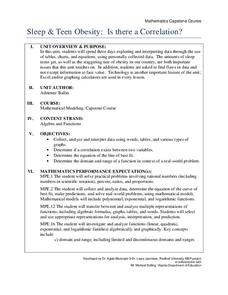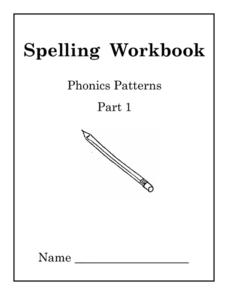Radford University
Sleep and Teen Obesity: Is there a Correlation?
Does the number of calories you eat affect the total time you sleep? Young mathematicians tackle this question by collecting their own data and making comparisons between others in the class through building scatter plots and regression...
Nuffield Foundation
How Much Energy Is There in Food?
People associate calories with food, but what is a calorie? Young scientists measure the number of calories in samples of food to better understand the concept. They test a variety of samples, take measurements, and compare their results...
NPR
Is There Really an Immigration Line?
If you've ever looked at the US immigration system, you know that it is complex and a source of controversy. An insightful lesson plan encourages learners to conduct their own analyses of the US immigration system by asking them to...
Model Me Kids
Model Me Going Places 2
Social stories are wonderful teaching tools specifically designed for learners with Asperger's, autism, PDD-NOS, non-verbal learning disabilities, or other developmental disabilities. They are used to model appropriate social behaviors...
Kathryn J. Davis
Spelling Workbook: Phonics Patterns
Set your pupils straight with spelling and sounds by using these materials for practice. Included here are three booklets and workbooks that cover just about any sound or blend you could think of!
Curated OER
Troublesome Words: What is a Troublesome Word?
Referring to words that are often used incorrectly, this resource identifies those "troublesome" terms that can produce confusion and shows learners how they should be used properly. Since even adults have trouble using such words as...
Curated OER
Avoiding There Are Poster
Encourage precise writing and the use of detail by banning there are from student work. You can put up this simple poster, which includes an image of there are crossed out and an example of how to avoid using the forbidden words.
Arkansas Government
Creative Adventures with Literature - Whoever You Are
Celebrate our similarities and differences through multiple readings of Whoever you Are by Mem Fox. Readings are accompanied by a grand discussion, charts, creative art, dramatic, and music play to reinforce the uniqueness that is found...
Curated OER
Is Modern Culture Ruining Childhood?
There are a lot of different ways a learner could respond to this New York Times article discussing the effects of modern culture on childhood. After reading the article, pupils construct a thoughtful blog post. The guiding questions...
Curated OER
When is a Noun a Verb? Examining Double Duty Words
Act and act, address and address...there are so many words in our dictionary that can function as nouns or verbs. Start this lesson by having your class list as many as they possibly can. When an adequate list presents itself, have your...
Curated OER
What Are Homophones?
A fun activity for homework, a warm-up, or a substitute day! Learners choose the correct word out of a set of homophones, such as made/maid and pale/pail, based on context clues in each sentence. There are twenty-two questions in all....
Polar Trec
What Is My Footprint?
How do one's habits and lifestyle choices affect the environment? Through a short online survey, learners will calculate their own carbon footprints then determine how to reduce their impact on the environment through simple steps, such...
University of Colorado
Are All Asteroids' Surfaces the Same Age?
There are more than 600,000 asteroids in our solar system. Pupils analyze images of two asteroids in order to determine if they are the same age. They count craters for each asteroid and compare numbers.
Curated OER
Is It Ethical to Eat Meat?
Have your class join a blog about whether or not eating meat is good for you. They'll read several passages regarding meat processing and consumption, then they post what they think. There are six critical-thinking prompts to help them...
WindWise Education
When is a Wind Farm a Good Investment?
When will a wind farm pay for itself? Individuals calculate the anticipated annual revenue for two proposed wind farms. By comparing the number of years it takes to pay back the initial investment, they determine which site makes the...
Curated OER
Their vs. There vs. They're Quiz
Do your pupils need extra practice with often-confused words? There are five opportunities on this quiz for your pupils to demonstrate they’re able to tell the difference between these words. They can even put the quiz in their notebooks.
University of Wisconsin
Teaching Things Fall Apart in Wisconsin: A Resource Guide for Educators
“There is no story that is not true, . . .” And uncovering the truths in Things Fall Apart is the focus of a 68-page resource packet designed to provide instructors with a wealth of materials that enhance understanding of Chinua Achebe’s...
Mt. San Antonio Collage
Review: Solving Equations
While there are many types of equations to solve, the main focus here is on quadratics. Starting with a quick review of the different methods, learners are guided through the solving process and are challenged to solve higher level of...
Curated OER
Unit 1: Water is Life: The Heart and Science Behind this Phrase
Water, water, everywhere — but will there be enough to drink? Check out these detailed lesson plans to meet NGSS water cycle and CCSS literacy standards in your science classroom. Learners do a close reading of a challenging, poetic text...
New South Wales Department of Education
Is it Alive?
Interestingly enough, movement is not a characteristic of living things. The first activity in a series of 20 introduces learners to the concepts of living versus non-living things and then focuses on biologists and what they study....
Wind Wise Education
Where is it Windy?
How is the wind up there? The class builds a topography model using materials available in the classroom, then place wind flags in different locations on the landscape. Using a fan as a wind source, pupils collect data about how wind...
Curated OER
Impersonal Pronouns: It and There
In this impersonal pronouns worksheet, students complete the text by typing "there is", "there are", "it is" or "it's" in the paragraph.
NOAA
Where There's Smoke, There's ...
A remotely operated vehicle approaching a volcano was engulfed by molten sulfur where the plumes of fluids contained the highest concentrations of aluminum ever recorded. This isn't science fiction or an April fools joke, though it did...
Alabama Learning Exchange
Ice Fishing is for the Birds
Approach addition with young mathematicians in an engaging way through this penguin-inspired activity. In small groups, scholars think about times they have used addition in their real lives (there are some suggestions given), then watch...

























